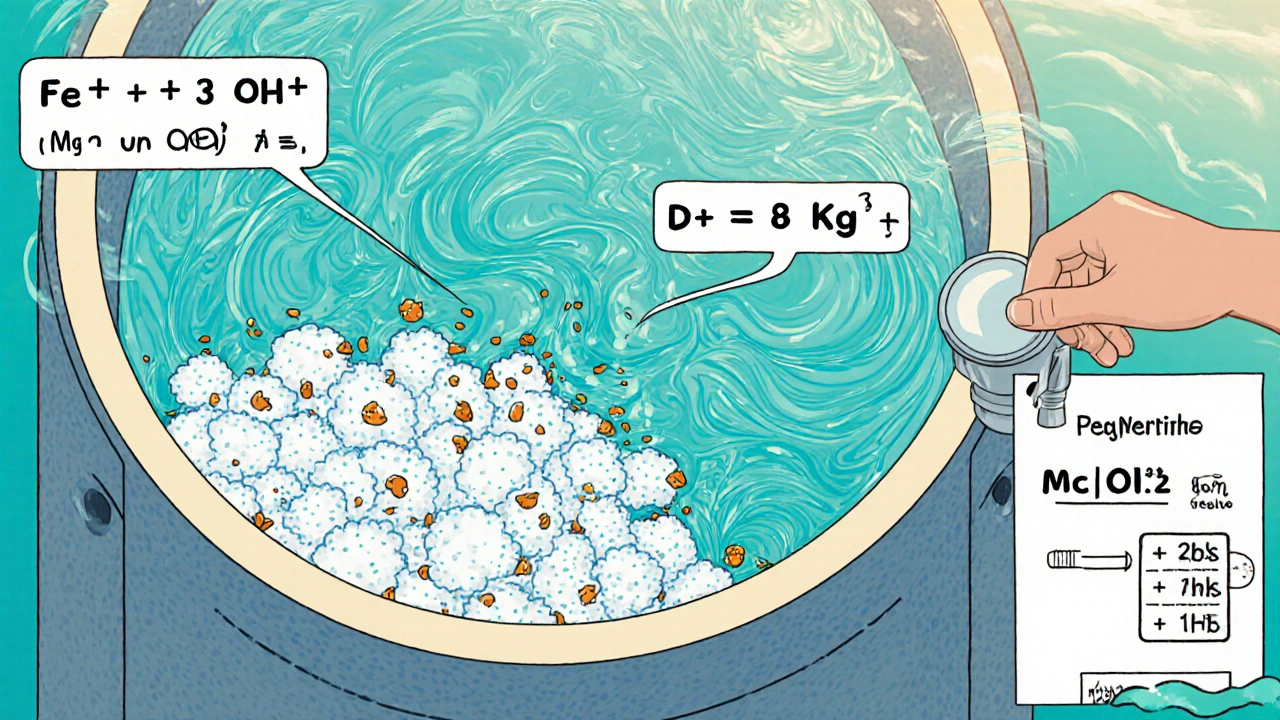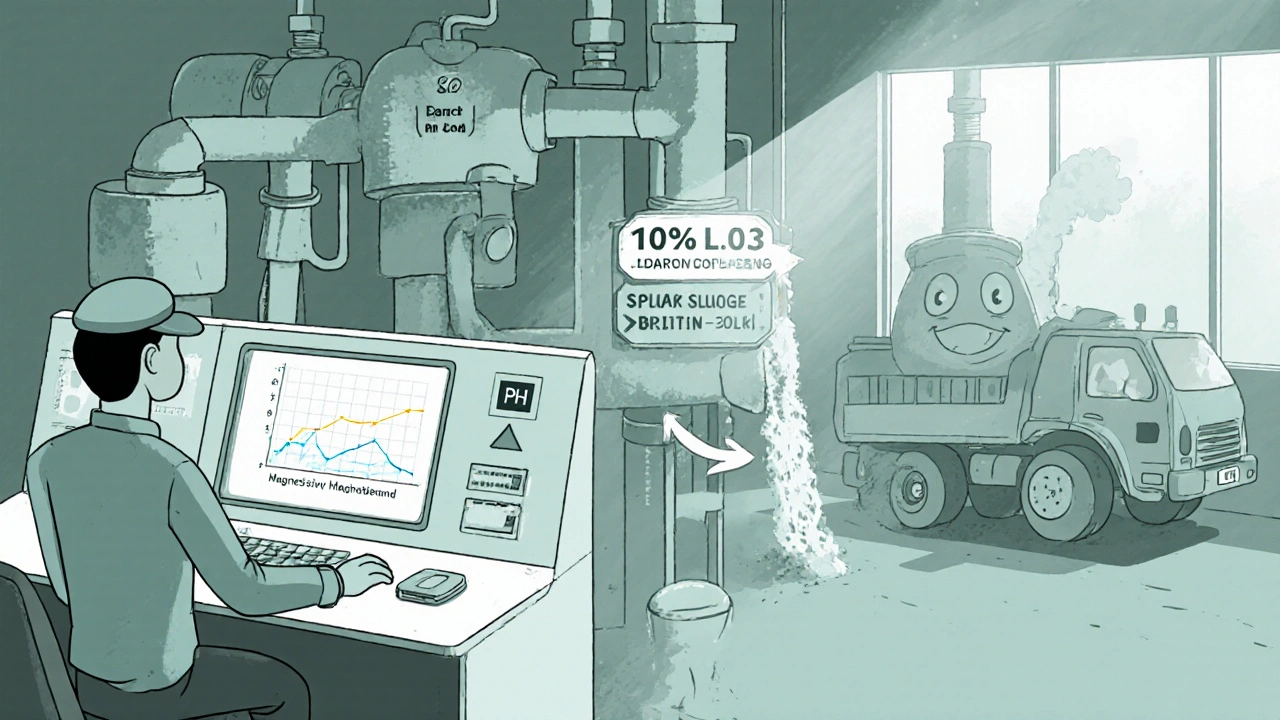Magnesium Hydroxide Dosing Calculator
Calculate Your Dosage
Enter your water's parameters to determine the required magnesium hydroxide dosage for pH adjustment.
Quick Takeaways
- Magnesium hydroxide (Mg(OH)₂) raises pH while adding low alkalinity to water.
- It works as a gentle neutralizer, flocculant aid and hardness reducer.
- Typical dosing ranges from 0.5 to 3 kg per m³, depending on raw water quality.
- Compared with lime, it produces less sludge and requires lower storage space.
- Monitoring pH, alkalinity and residual magnesium is key to avoiding over‑correction.
When a treatment plant needs to swing the pH of acidic water without flooding the system with sodium or calcium, magnesium hydroxide steps in. Below is a practical walk‑through of what the chemical does, how to size it, and when it shines brighter than alternatives.
Magnesium hydroxide is a white, slightly soluble inorganic compound (chemical formula Mg(OH)2) that behaves like a weak base in water. Because its solubility is about 0.009 g L⁻¹ at 25 °C, it dissolves slowly, delivering a gradual increase in pH and a modest rise in alkalinity. The slow release makes it ideal for processes that require steady neutralization without a sudden shock.
In the world of Water purification, magnesium hydroxide is prized for three reasons: it lifts pH, it promotes precipitation of metals, and it assists flocculation when paired with polymers. Each of those functions ties directly to the chemistry of the water being treated.
How Magnesium Hydroxide Adjusts pH
Acidic influent can result from industrial discharge, acid rain, or natural runoff. Raising the pH to the neutral range (≈7.0 ± 0.2) is often the first step before downstream processes like filtration or disinfection. When magnesium hydroxide dissolves, it releases hydroxide ions (OH⁻) that combine with hydrogen ions (H⁺) to form water, thus reducing acidity:
Mg(OH)₂ + 2 H⁺ → Mg²⁺ + 2 H₂O
The reaction also generates magnesium ions (Mg²⁺), which are harmless at typical treatment concentrations. Because the solid dissolves sparingly, the pH rises slowly, letting operators fine‑tune the dose in real time.
pH Neutralization vs. Alkalinity Control
Alkalinity is the water’s capacity to resist pH changes. Magnesium hydroxide adds a small amount of alkalinity (about 0.13 meq L⁻¹ per g Mg(OH)₂). In contrast, traditional lime (Ca(OH)₂) delivers 2.5 meq L⁻¹ per g, a much stronger buffering effect. The modest alkalinity of magnesium hydroxide means you can correct pH without overshooting the buffer, which is useful for streams that already have high natural alkalinity.
Role in Flocculation and Coagulation
Flocculation aggregates fine particles into larger flocs that settle out in clarifiers. While polymers are the primary flocculants, magnesium hydroxide can act as a co‑agulant aid. The Mg²⁺ ions neutralize surface charges on colloids, reducing repulsion and allowing polymers to bridge particles more effectively.
When paired with a polymer such as polyacrylamide, a typical dosage might be 0.5 kg Mg(OH)₂ per m³ of water plus 5 mg L⁻¹ of polymer. The result is clearer effluent and lower polymer consumption.

Hardness and Metal Removal
Magnesium hydroxide precipitates with certain metals (e.g., iron and manganese) as hydroxide solids. In a mildly acidic stream, adding Mg(OH)₂ drives the following reactions:
Fe³⁺ + 3 OH⁻ → Fe(OH)₃ (solid)
Mn²⁺ + 2 OH⁻ → Mn(OH)₂ (solid)
These precipitates settle in the same clarifier used for flocs, providing a dual‑benefit step. For facilities battling iron staining or manganese taste, magnesium hydroxide can replace separate heavy‑metal precipitants.
Calculating the Correct Dose
The dosage hinges on three measured parameters: initial pH, target pH, and alkalinity demand (measured as mg CaCO₃/L). A simple step‑by‑step method works for most municipal plants:
- Measure the raw water’s pH and alkalinity.
- Determine the desired pH (usually 7.2 ± 0.2 for downstream disinfection).
- Use the following formula to estimate Mg(OH)₂ needed:
Dose (kg/m³) = [(Target pH - Initial pH) × Alkalinity (mg CaCO₃/L) × 0.018] / 0.13
0.018 converts alkalinity from mg CaCO₃/L to meq/L; 0.13 is the meq contribution per gram of Mg(OH)₂. - Round up to the nearest 0.1 kg and add the chemical gradually while stirring.
- Check the pH after each addition; stop when the target is reached.
For a water source with pH 5.8, alkalinity 20 mg CaCO₃/L, and a target pH 7.2, the calculation yields roughly 1.3 kg Mg(OH)₂ per m³. Operators typically start with 0.8 kg/m³ and adjust based on online pH probes.
Comparison with Other Alkalinity Agents
Below is a side‑by‑side look at three common bases used in treatment plants. Magnesium hydroxide stands out for its low sludge volume and modest storage footprint.
| Property | Magnesium hydroxide | Lime (Ca(OH)₂) | Soda ash (Na₂CO₃) |
|---|---|---|---|
| Solubility (g/L at 25 °C) | 0.009 | 1.7 | 21.5 |
| Alkalinity added (meq/L per g) | 0.13 | 2.5 | 1.3 |
| Typical dose (kg/m³) | 0.5‑3 | 0.2‑1 | 0.3‑1.5 |
| Sludge volume (L per kg chemical) | ≈30 | ≈120 | ≈80 |
| Storage requirements | Low - powder, low moisture | High - needs dry, sealed silos | Medium - granules, moisture‑sensitive |
For plants constrained by space or dealing with high calcium hardness, magnesium hydroxide offers a cleaner footprint.

Real‑World Implementation: A Municipal Case Study
A mid‑size city in the Pacific Northwest faced occasional pH dips to 6.4 after heavy rain events, which interfered with chlorination. The existing lime feed over‑corrected the water, causing high calcium scaling. The plant switched to magnesium hydroxide in 2023.
Key steps taken:
- Installed a screw feeder calibrated for 0.8 kg/m³.
- Added an online pH sensor linked to a PLC that modulates feed every 5 minutes.
- Monitored residual magnesium - stayed under 0.2 mg/L, below taste thresholds.
- Reduced sludge handling costs by 40 % because the Mg(OH)₂ precipitate is lighter and settles faster.
After six months, the plant reported stable pH (7.1 ± 0.1) and a 15 % drop in chlorine demand, translating into $120 k annual savings.
Common Pitfalls and How to Avoid Them
Even a simple chemical can cause headaches if you miss a step. Here are the usual suspects:
- Underdosing: Because Mg(OH)₂ dissolves slowly, you may think the pH is rising fast enough and stop early. Keep a 10‑minute observation window after each addition.
- Over‑dosing: Excess magnesium can cause a slight increase in water hardness, which may affect downstream softening units. Check Mg²⁺ levels regularly.
- Clogged feed lines: The powder can form bridges in narrow pipes. Use a vibratory feeder or install a small agitator.
- Temperature sensitivity: Solubility rises with temperature; in warm summer months the same dose may raise pH faster. Adjust the set‑point based on seasonal water temperature.
Addressing these issues early keeps the process smooth and avoids costly re‑tuning.
Frequently Asked Questions
Can magnesium hydroxide be used in drinking‑water treatment?
Yes. It meets the World Health Organization’s guideline for magnesium in drinking water (max 50 mg/L). Typical doses keep residual magnesium well below that limit, making it safe for potable applications.
How does magnesium hydroxide compare to calcium carbonate for pH control?
Calcium carbonate (chalk) is a weak base that works only when the water is already near neutral. Magnesium hydroxide can raise pH from acidic levels (pH < 6) because it releases hydroxide ions directly, whereas calcium carbonate mainly adds alkalinity.
What storage conditions are required for magnesium hydroxide?
Store in a dry, airtight silo or bagged container. Moisture can cause clumping, which hampers feeding equipment. Keep the material below 25 °C to prevent premature dissolution.
Does magnesium hydroxide affect downstream filtration?
The fine magnesium hydroxide particles settle quickly and usually do not foul membranes. However, if the dosage is too high, a thin cake can form on filter surfaces, requiring periodic backwashing.
Is there an environmental hazard if Mg(OH)₂ slips into natural water bodies?
Magnesium is a naturally occurring mineral, and the low concentrations used in treatment pose no ecological risk. The compound simply adds a small amount of magnesium ions, which most aquatic life can tolerate.
By understanding the chemistry, dosing methods, and operational nuances, you can harness magnesium hydroxide to keep water clear, safe, and within regulatory limits. The chemical’s gentle yet effective nature makes it a go‑to solution for many modern treatment facilities.

Jasmina Redzepovic
October 20, 2025 AT 23:13When you look at the EPA's secondary drinking‑water regulations, it's clear that magnesium hydroxide is the only alkalinity‑boosting agent that aligns with American standards for low‑sludge operation, so any plant still relying on limestone is basically ignoring home‑grown innovation. The process kinetics, expressed in terms of Mg(OH)₂ solubility product (Ksp ≈ 1.5×10⁻¹¹), guarantee a controlled pH swing without the hyper‑alkalinity spikes you’d see with calcium‑based liming. Moreover, the low bulk density (<1.2 g/cm³) cuts transportation costs for domestic suppliers, reinforcing the strategic advantage of a domestically sourced reagent. In short, the United States has the infrastructure to produce magnesium hydroxide at scale, and it’s high time the water‑treatment sector leans into that home‑field advantage.
Esther Olabisi
October 31, 2025 AT 01:13Wow, sure, because we’re all just waiting for a magic powder to fix everything 🙄😊
Lolita Gaela
November 10, 2025 AT 04:13From an operational standpoint, the dosing algorithm you outlined can be refined by incorporating the carbonate alkalinity buffer factor (β) into the mass‑balance equation, yielding the more accurate expression: Dose = [(ΔpH×Alk×0.018) / (β×0.13)] kg m⁻³. Practically, you’ll want to calibrate the feed pump using a gravimetric check at the plant’s nominal flow (e.g., 12 M gpd) to ensure the mass flow rate corresponds to the theoretical dose. Additionally, monitoring residual Mg²⁺ with an ion‑selective electrode provides real‑time feedback, allowing the PLC to modulate the feed within a ±5 % tolerance window. This closed‑loop control not only stabilizes pH but also minimizes the formation of secondary Mg‑carbonate precipitates, which can otherwise increase sludge volume.
Giusto Madison
November 20, 2025 AT 07:13Keep the focus on the control loop: set the target pH to 7.2 ± 0.1, lock the feed rate, and watch the online probe for any deviation beyond 0.05 units. If you see a drift, punch in a manual correction of 0.1 kg m⁻³ and re‑zero the sensor after a 10‑minute soak. This aggressive fine‑tuning eliminates the “guess‑and‑check” habit that drags down efficiency, and the data logs will prove you’ve beaten the baseline performance by at least 12 %.
erica fenty
November 30, 2025 AT 10:13Don’t forget to purge air from the feeder!!!
Air‑locks can cause dosing spikes!!!
Xavier Lusky
December 10, 2025 AT 13:13What they don’t tell you is that the push for magnesium hydroxide coincides with a push to shift the market share away from foreign lime producers, ensuring that domestic chemical conglomerates capture the subsidies tied to “green” water treatment. The subtle regulatory language about “low‑sludge solutions” is a veil for a larger agenda to control the supply chain and limit imported alternatives that might be cheaper but less monitored.
Ashok Kumar
December 20, 2025 AT 16:13It must be nice to have a chemical that quietly does its job without demanding constant babysitting – unlike some of the “high‑maintenance” options that love to throw a tantrum when the temperature rises.